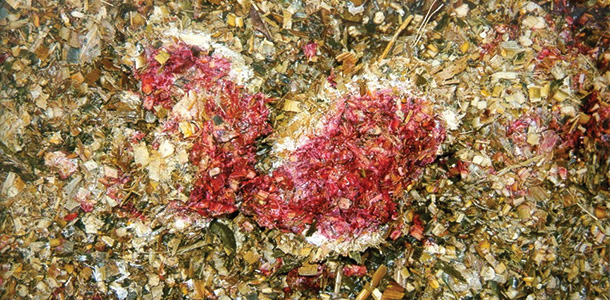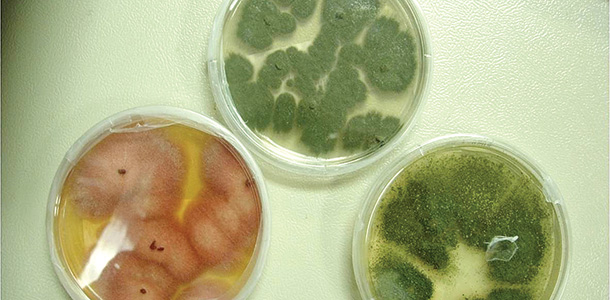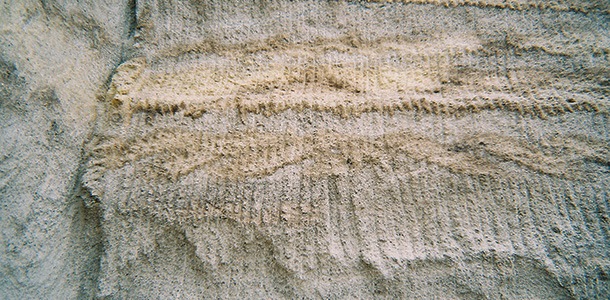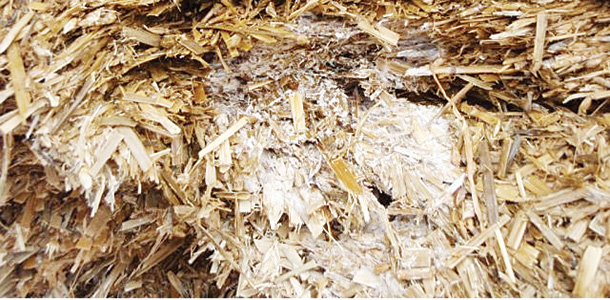Even after an ideal growing season, ensiling conditions can set the stage for mycotoxins to develop in silage from storage mold growth.

Monascus ruber
The best way to minimize mold development is to produce an efficient fermentation for reduction of pH and to pack silo and bunkers well to eliminate oxygen in the silage.
Unfavorable weather events and less-than-ideal harvest and ensiling practices can lead to conditions that could favor mold development.
If growers were forced to harvest forages at low moisture levels, or weren’t able to fill, pack and cover the silo or bunker rapidly, a low pH level will not be attained and oxygen from the air will penetrate the silage.
The use of bacterial inoculants will not prevent silage molding issues if silage producers miss proper moisture and maturity, filling, packing and covering management practices.

Mold cultures
Storage molds originate from soilborne spores that are brought into the silo with all forages. Mold spores won’t grow if good silage management practices exist.
Molds damage silage quality and in severe cases lead to the development of dangerous mycotoxins that can make silage unfit for livestock consumption.
Storage molds require oxygen to sporulate and begin growing in silages. Usually, storage mold growth occurs when pH is greater than 4.5, which is a result of yeast activity that can occur at low pH levels in the presence of oxygen and causes pH to rise above 4.5.
One exception is Penicillium mold, which can grow in the presence of oxygen even at low pH levels and likely is why it’s the most commonly isolated mold in silage samples.
The use of combination bacterial strain inoculants that contain Lactobacillus buchneri will impede yeast activity during feedout, thus minimizing chances for most molds to grow secondarily when less-than-ideal silo face management exists.
Most molds identified in silages usually result in lowered palatability and nutrient value. However, molds also can produce other mycotoxins that standard laboratory tests don’t look for.
The good news is that well-managed and well-preserved silages are not prone to becoming moldy.
Therefore, an ultimate goal should always be to ensile forages using best management practices during harvest, filling, storage and feedout. This eliminates oxygen and maintains a pH environment of 4 or lower throughout the silo.

Penicillium roqueforti, silage-specific molds and mycotoxins
The three most common molds isolated from silages are Penicillium roqueforti, green-blue in color; Aspergillus fumigatus, yellow-green in color; and Monascus ruber, red in color and surrounded by white. The easy way to differentiate is by color. Other common spoilage molds include Mucor and Monilia, which typically are white to grayish in color.
The primary feeding concerns related to storage molds are reduced silage nutritional quality, bunk life and palatability.
While most molds do not produce harmful mycotoxins, research shows Penicillium mold is capable of producing several dangerous ones.
This is a major concern because Penicillium can grow at low pH levels. In monogastrics, such as pigs and chickens, some resulting mycotoxins produced in molding grain can produce liver and kidney problems.
A common toxic effect in cattle exposed to any storage-produced mycotoxins is a change in ruminal flora makeup, which alters rumen fermentation.

Mucor mold
Long-term feeding of moldy silages can produce local inflammatory responses that may lead to rumenitis. A ruminant’s other body systems also can be affected by storage mold mycotoxins if high concentrations enter into the blood system.
Several mycotoxins cause neurological damage at high doses. However, this is a minor concern in cattle because they generally ingest fairly low doses of these mycotoxins.
Gliotoxin from Aspergillus fumigatus is of interest in dairy cattle because research shows correlations with cattle bronchitis, mastitis and incidental abortions.
Gliotoxin in conjunction with Clostridium perfringens type A has been identified as a possible cause of hemorrhagic jejunal syndrome in dairy cattle.
Hemorrhagic jejunal syndrome is an acute disease in dairy cattle characterized by an acute drop in milk production, abdominal pain due to hemorrhagic and obstructed intestines, and dehydration. Death can come within 48 hours from the onset of the syndrome.
Veterinary toxicologists warn that the presence of A. fumigatus alone does not necessarily result in hemorrhagic jejunal syndrome events in dairy cattle – many other factors come into play, including ration formulations and pre-existing subacute rumen acidosis events.
Prevention of storage molds and mycotoxins
There are several important steps to preventing storage mold growth through feedout. Silo size should be appropriate for the herd size to ensure daily removal of silage at a rate faster than deterioration can occur.
In warm weather, it is best to remove a foot of silage daily from the feeding face of horizontal silos. Remove the silo face cleanly and disturb it as little as possible to prevent air penetration into the silage mass.
Be careful not to remove excess plastic covering from the surface during silage feedout to minimize chances of top mold activity.
Feed silage (or other wet feeds) immediately after removal from storage, do not feed spoiled silages and clean feedbunks regularly.
Obviously, moldy feed should be avoided. Spoilage or deteriorated silage can reduce feed consumption, fiber digestibility and production.
If unacceptably high levels of mycotoxins are present, producers often can dilute the feed with uncontaminated silage. If not, they should discard contaminated feed. ![]()
PHOTOS
Photos courtesy of DuPont Pioneer.

Senior Nutritionist
DuPont Pioneer







